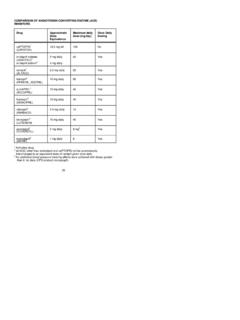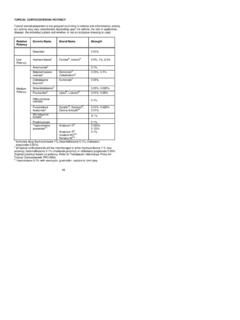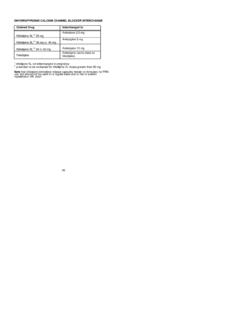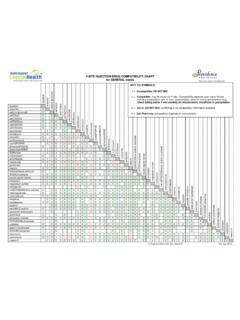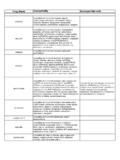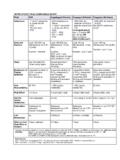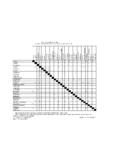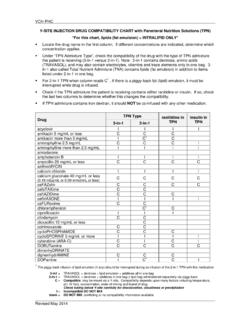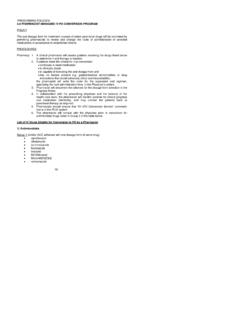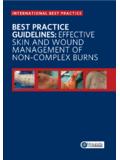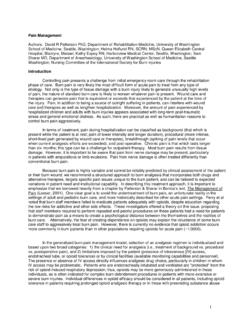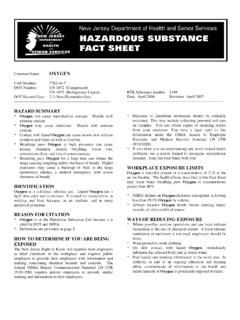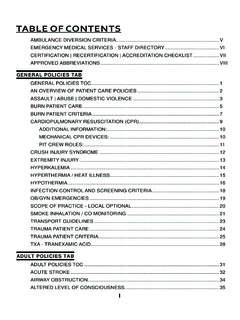Transcription of Vancomycin Therapeutic Drug Monitoring …
1 Vancomycin Regional Guideline September 27, 2011 1 Vancomycin Therapeutic drug Monitoring vancouver Coastal Health & Providence Health Care Regional Guideline Sept. 27, 2011 (Version ) Developed by: Jane de Lemos, Tim Lau, Mike Legal. Endorsed by: Terri Betts, Mark Collins Jane de Lemos, Robin Ensom, Rob McCollom, Nilu Partovi, Steve Shalansky, Tim Lau, Mike Legal. First Version Approval Date: March 12th 2009 Background At VCH-PHC, Vancomycin Therapeutic drug Monitoring practice varies considerably between the sites. This variance reflects the differences in institutional recommendations for indications for serum level Monitoring and how pharmacists respond to these levels. This diversity is in part due to poor quality evidence that links specific levels to improved outcome. Currently, at certain sites pharmacists can spend a considerable amount of time evaluating Vancomycin serum levels.
2 These levels are associated with significant costs (pharmacist time, patients blood loss, and laboratory costs). Therefore, there is an opportunity to both optimize the pharmacists time for other clinical activities and reduce costs associated with unnecessary laboratory tests. This guideline aims to identify the best clinical practice for Vancomycin Monitoring by defining indications for ordering Vancomycin serum levels and providing guidance on how levels should be evaluated. Essential factors that are being considered include the pharmacokinetic and pharmacodynamic properties of Vancomycin , the evidence for target levels and its association with efficacy and toxicities, the MIC of the target pathogens, and the expected patient benefit from a precise pharmacokinetic evaluation. Goals Application of best clinical practice across sites should achieve the following goals: Reduce the number of Vancomycin serum levels routinely ordered when either: o a level less than 15 mg/L is targeted OR o a post level is ordered to determine precise pharmacokinetic parameters.
3 Increase the pharmacists time for other clinical activities. Vancomycin Regional Guideline September 27, 2011 2 Objectives To provide recommendations for: 1. Target Vancomycin serum levels for specific indications and pathogens. 2. Indications for levels: : a pre-level only is required : post-levels are required : pre- and post-levels set is required. 3. Evaluation of patients not clinically responding. 4. Dosing strategies for low level ~ 10 mg/L and high level 15 to 20 mg/L targets. General Recommendations These recommendations provide guidance to Vancomycin dosing and Monitoring . The pharmacist may use their professional judgment in patient-specific scenarios and deviate from these recommendations if deemed clinically appropriate. Unless otherwise stated, the term level refers to the pre-level. Target levels may be categorized as: low level (~ 10 mg/L) and high-level (15 to 20 mg/L), reflecting different target pathogens and infection sites.
4 It is important to ensure that an adequate mg/kg dose and interval are ordered, as soon as the patient is reviewed and to adjust the regimen if necessary rather than to wait for a confirmatory pre-level. For patients under 40 years of age with good renal function, the dosing interval should be adjusted to Q8H; for dosing protocols that use a 25 mg/kg load with a 15 mg/kg maintenance dose Q12H would generally achieve levels close to10 mg/L. A dosing nomogram designed to achieve high target levels of 15 to 20 mg/L has been developed and validated. The use of a serum creatinine value post fluid resuscitation is recommended rather than relying on the initial serum creatinine that is reported on admission or immediately post-operatively (which may be elevated pre-resuscitation). Serum creatinine may not be a reliable marker of renal function in some populations, such as the frail elderly, nutritionally deficient, anorexic, or HIV population.
5 In these populations estimations of dosing interval should be based on age and a conservative approach to selecting the interval (selection of a less frequent dosing regimen than suggested by the creatinine). Changes in serum creatinine may be helpful in detecting/predicting Vancomycin accumulation. Relative increase of greater than 15-20% from baseline (regardless of whether or not the creatinine is in the normal range) may indicate a decline in renal function significant enough to cause Vancomycin accumulation. Such changes may warrant a Vancomycin pre-level. Vancomycin Regional Guideline September 27, 2011 3 Specific Recommendations 1. Target Vancomycin levels for specific indications and pathogens Table 1. Target Vancomycin pre-levels for specific indications #mcri 2. Indications for levels Pre-Levels a. Pre- Vancomycin level drawn no earlier than the 3rd dose and within 48 hours or as per clinical judgment if: a higher level of 15-20 mg/L is desired OR patient is at risk for accumulation ( Q8H interval) OR patient is receiving other nephrotoxic agents OR serum creatinine is above normal, renal function is changing or uncertain OR patient is obese (>125% IBW) (Appendix 1), pregnant (Appendix 2), pediatric (0-18 years of age) (Appendix 2), or hypermetabolic ( burn patient, cystic fibrosis).
6 Repeat at least weekly to ensure pre- Vancomycin level is within desired Therapeutic range. Clinical judgment may be used here especially for prolonged Vancomycin courses where 2-3 pre-levels over the course of 2-3 weeks have been within target providing regular (2-3X week) serum creatinine ordered. b. Pre- Vancomycin level after 7 days of therapy (for prolonged course) if aiming for levels < 15 mg/L AND no other risk factors as per above. c. Pre- Vancomycin level if patient is not responding to therapy. Conditions requiring pre-levels 15 mg/L to 20 mg/L (high-level) Catheter-associated bacteremia CNS infection Deep-seated or sequestered infection ( abscess) Endocarditis Osteomyelitis MRSA bacteremia, pneumonia, or skin and soft tissue infection MSSA bacteremia (penicillin allergic patient) Conditions requiring pre-levels ~ 10 mg/L (low-level) Skin and soft tissue infection not due to MRSA Urinary tract infection (catheter-associated; rule out bacteremia) Vancomycin Regional Guideline September 27, 2011 4 Post-Levels a) Stable but impaired renal function Load patients with 20 to 25 mg/kg of Vancomycin .
7 Patients with stable renal function and CrCl less than 24 mL/min: o Order two post-distributional levels typically 3 hours and 24 hours post dose or as per clinical pharmacist judgement. Patients with an estimated CrCl of 24 to 48 mL/min: o Empirically dose at a Q36H to Q48H interval AND obtain a single pre-level for these patients at an appropriate time to identify if adjustments in the regimen are required OR o At sites where this is not yet routine practice, can order 3 hours and 24 hours levels then interpret and adjust regimen. b) Acute unstable renal function. All patients should receive an appropriate loading dose of 25 mg/kg (or 30 mg/kg if critically ill in the ICU). Subsequent dosing can be guided by performing random levels timed appropriately (usually close to the time when a repeat dose may be needed) to allow repeat dosing to maintain levels within the desired target until the renal function stabilizes.
8 Pre and Post-levels Pre- and post-levels are not routinely recommended. Pre- and 3 hour post- Vancomycin level (target 20-40 mg/L) should be drawn if calculation of precise kinetic parameters are necessary ( in a case when a target pre- Vancomycin level of 15-20 mg/L cannot be achieved while on prolonged therapy, or in an obese, pregnant or pediatric patient (Appendix 2), especially when aggressive dosing It is not recommended to perform routine pre- and post-levels for endocarditis, meningitis, and life-threatening conditions to establish kinetic parameters. Rather, it is recommended that for these indications the pharmacist focus immediately on ensuring appropriate adjustments of dose and or interval to ensure rapid attainment of a pre-level of 15 mg to 20 mg/L within 48 hours and to use their judgment to subsequently adjust the doses and or intervals. Two Post-levels For patients with unstable or reduced renal function, the clinical pharmacist should assist in determining the appropriate dosing regimen.)
9 These patients may require a loading dose and subsequent post-levels ( 3 hour and 24 hour post-dose serum levels) to ensure Therapeutic serum levels are achieved. 3. Evaluation of patients not clinically responding Vancomycin Regional Guideline September 27, 2011 Evaluation of a pre-level in patients not clinically responding when target is low-level ~10 mg/L In general, if the patient is receiving adequate mg/kg dosing and interval based on the age, weight and serum creatinine for low target levels, Monitoring is not needed for the first 7 days. However, if a lack of clinical response cannot be explained by other factors, the regimen should be adjusted to ensure the level is increased to a high level target of 15 mg/L to 20 mg/L and a pre-level taken to confirm that the target is reached. When the target level of more than 15 mg/L has been achieved If the patient is not responding clinically (especially if the organism is repeatedly isolated), this may signal that the MIC is close to 2 mg/L.
10 Higher levels (20 to 25 mg/L) may be needed. This is particularly important if the target site is sequestered. If available, an Infectious Disease consult is recommended and/or consideration of alternative or additional agents is warranted. 4. Dosing strategies for low and high levels Adult dosing recommendations The emphasis should always be on providing an initial correct dose and interval following the nomogram. (Table 1). Vancomycin Regional Guideline September 27, 2011 6 Table 2. Vancomycin empiric dosing guidelines VCH-PHC Vancomycin Empiric Dosing Guidelines (June 2011) Vancomycin Regional Guideline September 27, 2011 7 Dosing recommendations for children and pregnant women (see Appendix 2) Further information explaining the rationale behind the recommendations is provided in Appendix 3. Vancomycin Regional Guideline September 27, 2011 8 Appendix 1 Dosing Recommendations for Obese Patients The formal definition of obesity is defined as a BMI of 30 or more.
